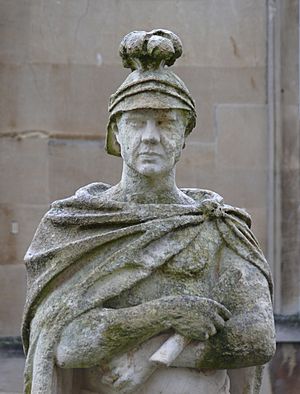Gaius Suetonius Paulinus facts for kids
Quick facts for kids
Gaius Suetonius Paulinus
|
|
|---|---|

Statue of Gaius Suetonius Paulinus on the terrace of the Roman Baths in Bath, Somerset
|
|
| Born | before 40 AD Probably Pisaurum (modern Pesaro) |
| Died | after 69 AD |
| Allegiance | Roman Empire |
| Wars |
|
Gaius Suetonius Paulinus was a Roman general who lived from about 40 AD to 69 AD. He is most famous for defeating a big rebellion led by Queen Boudica in Britain.
Contents
Early Life of a Roman General
We don't know much about Suetonius's family. They probably came from Pisaurum, a town in Italy. Today, this town is called Pesaro. He was not related to the famous writer Suetonius.
Campaign in Mauretania
In 40 AD, Suetonius served as a praetor, a high-ranking Roman official. The next year, he became the governor of Mauretania. This area is in modern-day North Africa.
He worked with another general, Gnaeus Hosidius Geta. Together, they stopped a rebellion led by Aedemon. This uprising happened after the Roman emperor Caligula executed the local ruler.
In 41 AD, Suetonius was the first Roman commander to lead troops across the Atlas Mountains. Pliny the Elder, a Roman writer, even quoted Suetonius's descriptions of this area in his book Natural History.
Governor of Roman Britain
In 58 AD, Suetonius was made governor of Britain. He took over after the previous governor, Quintus Veranius, passed away. Suetonius continued the plan to take control of the tribes in what is now Wales.
He was very successful in his first two years. His skill as a general became as well-known as that of Gnaeus Domitius Corbulo. Two future governors of Britain served under him. These were Quintus Petillius Cerialis and Gnaeus Julius Agricola.
The Attack on Anglesey
In 60 or 61 AD, Suetonius launched an attack on the island of Mona, which is now called Anglesey. This island was a safe place for British people who were fighting the Romans. It was also a strong center for the druids, who were important religious leaders.
While Suetonius was away, tribes in the south-east of Britain started a rebellion. This uprising was led by Queen Boudica of the Iceni tribe.
Boudica's Rebellion
After dealing with Mona, Suetonius marched his army along the Roman road called Watling Street. His goal was to reach Londinium, which is modern-day London. This city was the rebels' next target.
However, Suetonius decided he didn't have enough soldiers to defend Londinium. So, he ordered everyone to leave the city. The British rebels then destroyed Londinium. They also destroyed Verulamium, which is now St Albans.
The Battle of Watling Street
Suetonius gathered his forces. He had soldiers from the Fourteenth Legion and parts of the Twentieth Legion. He also had many auxiliary troops, who were non-Roman soldiers.
Another legion, the Second Legion, was available but its commander refused to join. Even so, Suetonius managed to gather about ten thousand men. The British rebels greatly outnumbered them. Some reports say there were 230,000 Britons.
The Romans stood their ground in a narrow valley with a wood behind them. The exact location of this battle is unknown. It was likely somewhere in the West Midlands along Watling Street.
Roman tactics and discipline helped them win against the larger British army. The Britons' families were in wagons at the edge of the battlefield. This made it hard for them to escape when they started to lose.
The battle turned into a huge defeat for the Britons. Reports say that almost eighty thousand Britons were killed. Only about four hundred Romans died. After the defeat, Boudica took her own life.
Aftermath of the Rebellion
Suetonius brought in more soldiers from Germania. He then carried out harsh actions against any remaining groups of rebels. However, this only made the fighting continue.
The new Roman official in Britain, Gaius Julius Alpinus Classicianus, told Emperor Nero that Suetonius's actions were making things worse. An investigation was started. An excuse was found to remove Suetonius from his command. He was replaced by Publius Petronius Turpilianus, who was more peaceful.
Suetonius was not disgraced, though. A lead token found in Rome has both his name and Nero's name on it. It also shows symbols of victory. A man named Gaius Suetonius Paulinus was a consul in 66 AD. This might have been the general himself, serving a second time.
The Year of Four Emperors
In 69 AD, after Emperor Nero died, there was a period of civil wars. This time is known as the Year of Four Emperors. Suetonius was a senior general and advisor to one of the emperors, Otho.
Suetonius and another general, Aulus Marius Celsus, defeated Aulus Caecina Alienus. Caecina was a general for Vitellius, another emperor. This battle happened near Cremona.
However, Suetonius did not let his soldiers follow up on their victory. Because of this, he was accused of being a traitor. When Caecina joined forces with another general, Fabius Valens, Suetonius advised Otho not to risk a big battle. But Otho did not listen.
This led to Otho's major defeat at Bedriacum. Suetonius was captured by Vitellius. He was pardoned after claiming he had purposely lost the battle for Otho. This was probably not true. What happened to Suetonius after this is not known.

